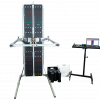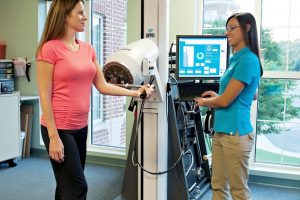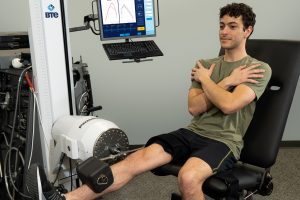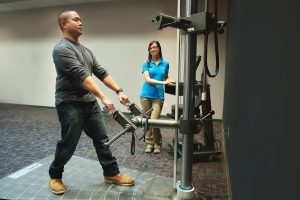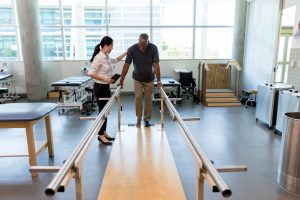
Endurance Testing: Speed, ROM, Resistance
Treatment GuidelinesRegardless of the activity the individual is trying to return to, endurance is a prime consideration for tasks which require repeated movement at a submaximal level. This is an important component of function since the majority of muscles must work continually during most activities.
In rehab and training, endurance testing is sometimes just as important as measuring strength. Once the client has recovered strength, your focus may shift to their ability to complete specific tasks over a period of time.
Endurance testing looks at how long strength lasts until fatigue sets in. Let’s take a look at how endurance testing compares to strength testing, how it works in rehab and training, and the variables for speed, ROM, and resistance.
Starting with strength
When measuring a client’s current performance status, it is common to measure their maximum strength value. This is a necessary starting point to document any strength loss due to injury. Comparing the strength of a muscle group of the injured extremity to the same muscle group of the non-injured extremity is an excellent way to document a strength loss.
Clinics commonly use a grip and pinch dynamometer for hand strength documentation. For other larger muscle groups, a portable force gauge or other manual muscle strength testing device can be used for objective and reproducible strength testing.
Set a baseline with objective measures
These objective strength readings can be the starting point when designing a rehabilitation program. Identifying a deficit is important to make sure treatment exercises target the right area.
Repeat testing can show if the involved area is getting stronger. A successful rehabilitation program should improve the strength so that both sides (injured and uninjured) develop equal strength.
But, this is only half the picture. Once a client has recovered the needed strength, they need to be able to use that strength productively. People need strength to be functional, but they also need to maintain a certain strength level to be able to complete tasks.
In order to thoroughly evaluate muscle performance, it is important to look at all aspects of the affected muscle group. That means not only strength gains, but also endurance capacity.
Endurance testing vs strength testing
Strength is the maximum force output at which a muscle contracts under load. Endurance is how long the strength lasts before fatiguing. Compared to strength, endurance training and testing is slower paced, under lighter loads, and for longer periods of time.1
The difference between strength versus endurance is the type of muscle fibers that are active. Type I, or slow twitch muscle fibers, are smaller and more fatigue-resistant, which is better for low levels of force over longer periods of time. Type II, or fast twitch muscle fibers, are better for quick and powerful contractions, and fatigue quickly under maximum loads.2
Endurance is key for everyday function
Everyday activities require different types of muscles. For example, a quick jog requires strength, but maintaining posture throughout the day requires endurance. It is quite possible for someone returning from an injury to have recovered strength and power but lack the endurance to return to work or sport.
Regardless of the activity the individual is trying to return to, endurance is a prime consideration for tasks which require repeated movement at a submaximal level. This is an important component of function since the majority of muscles must work continually during most activities. By measuring the amount of work generated, or length of time an activity is sustained, the duration of muscle performance can be quantified.3
Endurance test parameters: speed, ROM, resistance
When evaluating muscle endurance, it is important to control the parameters of the test. You should test both sides (injured vs non-injured, or dominant vs non-dominant) under similar conditions.
Variable conditions include the speed of movement, the range of motion, and the resistance or force. These parameters should be close to the same for each side to make sure the data collected will be a fair comparison.
It is necessary to make sure the client works at the same speed with both sides, in order to ensure the level of fatigue is consistent. A timing cycle metronome can help control the client’s speed. Listening for the metronome, the client performs one complete repetition for each cycle.
If there is a different range of motion between sides for the muscle group being tested, the evaluator should restrict the ROM for the uninvolved side so it’s close to the involved side. The same is true for the resistance or force setting.
If one or more of these parameters is significantly different, then the sides are not being testing under the same conditions. Therefore the data will not be comparable. In order to get the most reliable data for return-to-function, you must use objective measurement.
Task simulation and evaluation technology like the PrimusRS help you set precise parameters for speed, ROM and resistance. Using objective measurement removes the guesswork from making return to function decisions. Precise and objective measurement yields better data and better outcomes for you and your clients.
Endurance testing in rehabilitation
Endurance testing may not be appropriate early in the rehab process. For example, when there is a significant difference between the injured and non-injured strength, there won’t be an endurance test that’s fatiguing to both sides. The parameters would either be too challenging or not engaging enough for one side. In this case, your will first be to build up the injured strength. Only then can you measure ability to use strength for endurance activities.
Adequate assessment of muscle endurance is paramount to establish an appropriate treatment plan. The quicker a muscle fatigues, the more likely it is to suffer injury.
Whether in rehabilitation or athletic training, endurance testing and training provide several benefits, including increasing the capacity for Type I slow twitch muscles. It can help prepare clients for everyday activities, job functions, and sports. With precise and objective evaluation, endurance testing can yield reliable results and help clients achieve their goals.
Jonathan Cooper, VRT, CEAS
Clinical Specialist
BTE
References
- Ebben WP, Kindler AG, Chirdon KA, Jenkins NC, Polichnowski AJ, Ng AV. (2004). The effect of high load VS repetition training on endurance. J Strength Cond. https://www.ncbi.nlm.nih.gov/pubmed/15320677
- Martini, F. H. Fundamentals of anatomy and physiology textbook, Chapter 10. Pearson.
- Campos GE, Luecke TJ, Wendeln HK, Toma K, Hagerman FC, Murray TF, Ragg KE, Ratamess NA, Kraemer WJ, Staron RS. (2002). Muscular adaptations in response to three different resistance-training regimens: specificity of repetition maximum training zones. Eur J Appl Physiol. https://www.ncbi.nlm.nih.gov/pubmed/12436270

